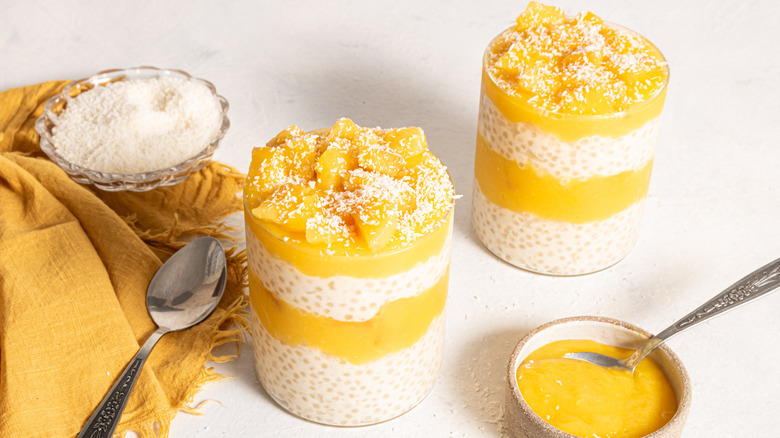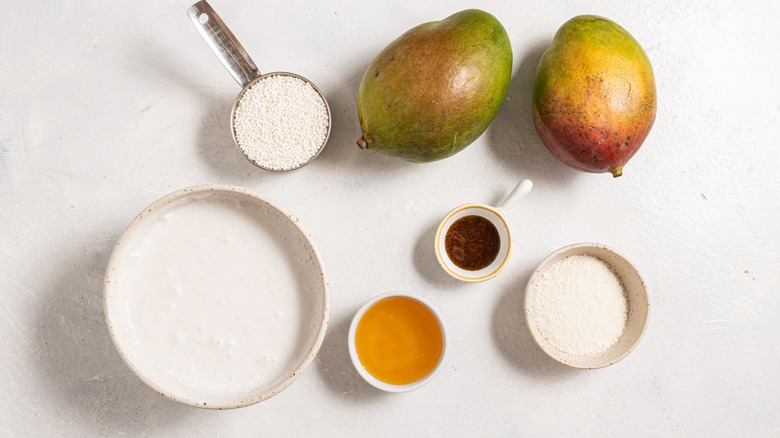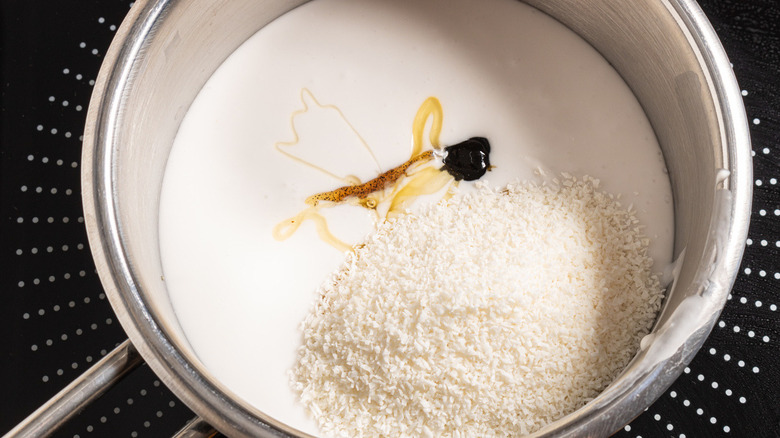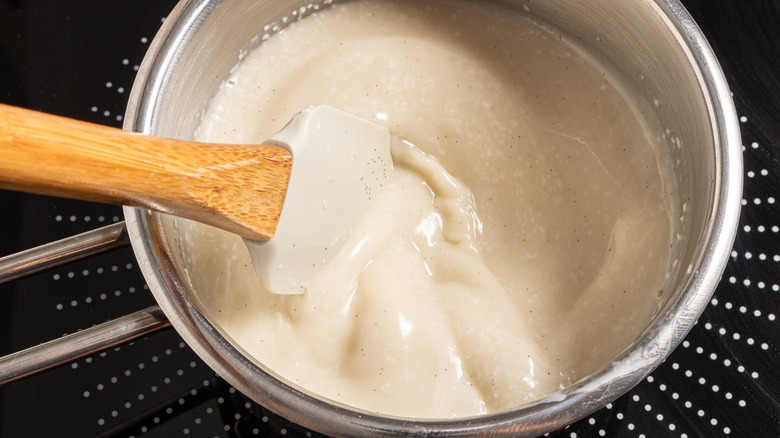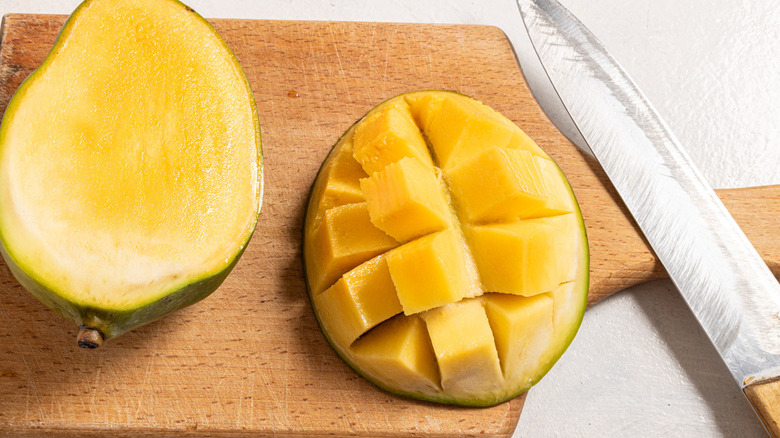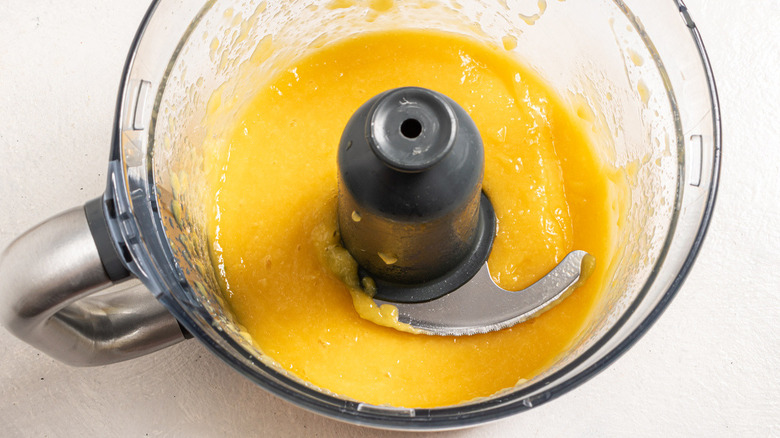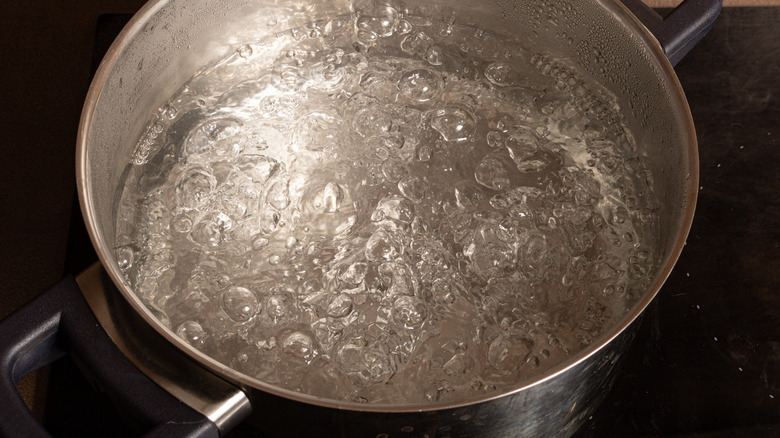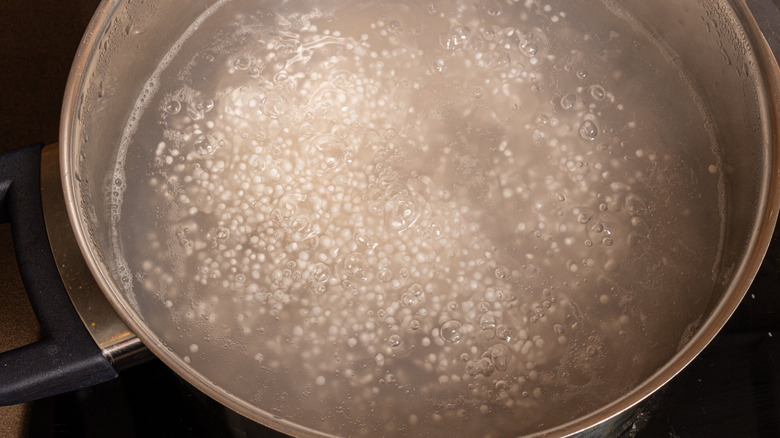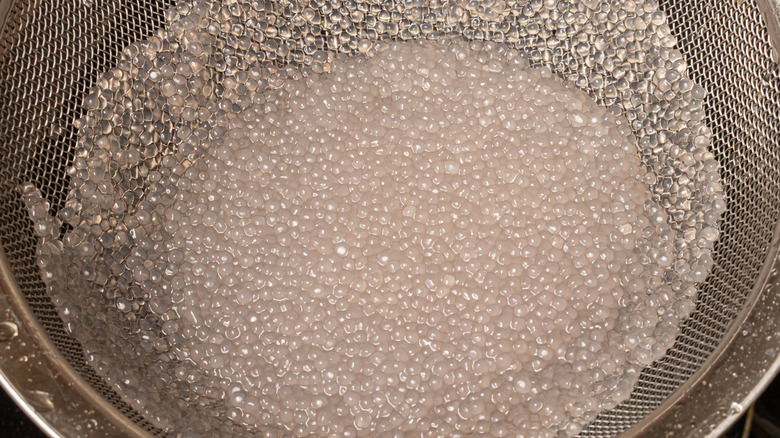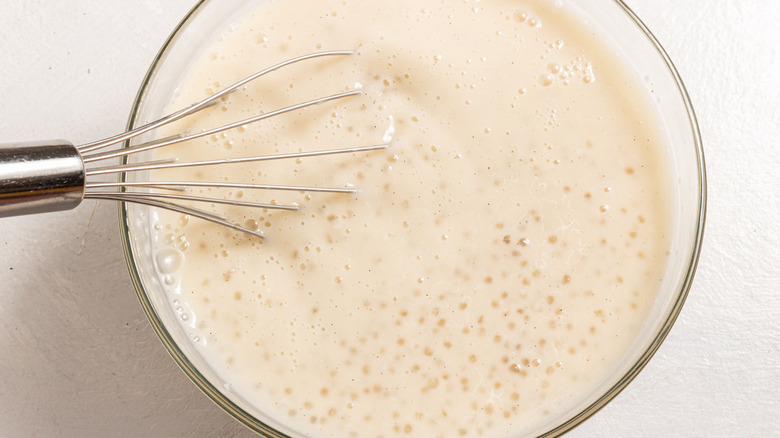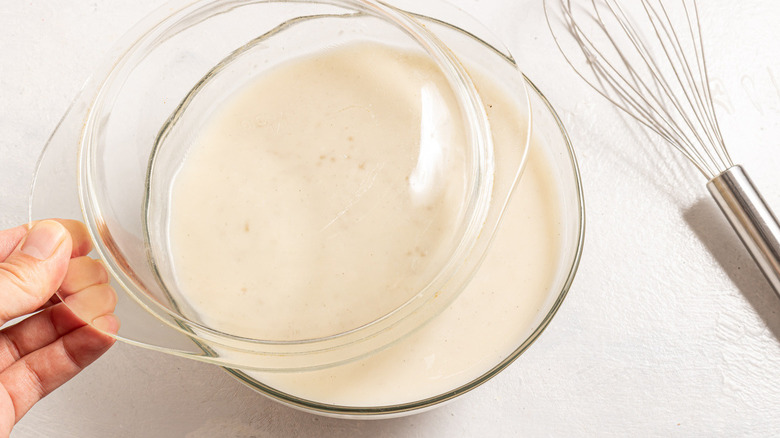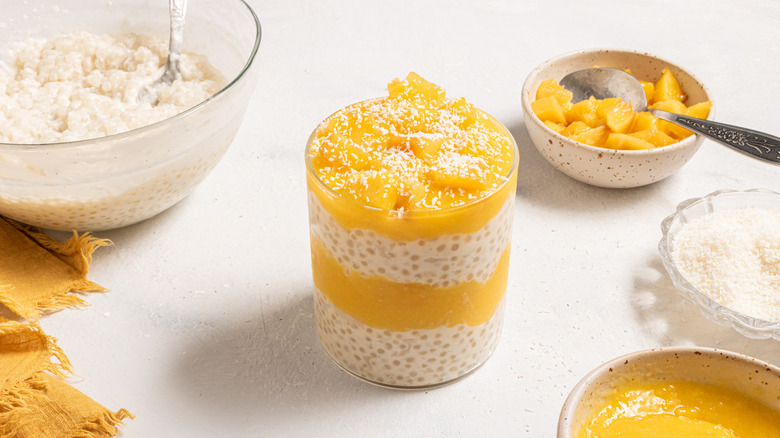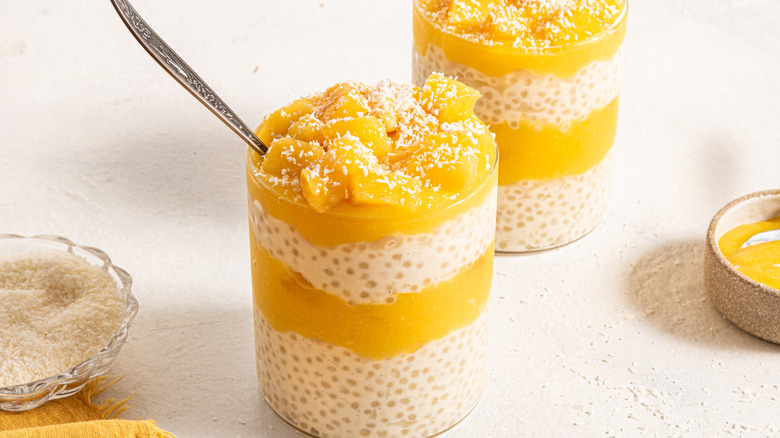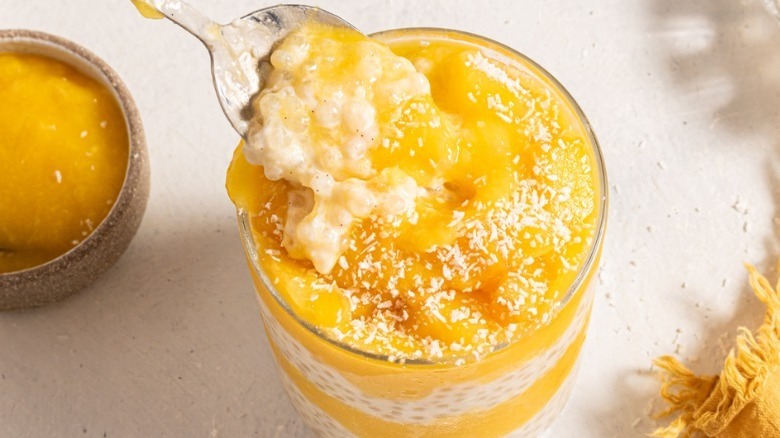Mango Sago (Mango Coconut Tapioca Pudding) Recipe
Tropical fruits always make us think of summer, and this mango sago coconut pudding couldn't be much more tropical — in the words of developer Milena Manolova, it makes for "the perfect summer dessert ... a delicious, light, and refreshing end to a meal." As befits this busy season, the dessert is also pretty effortless, as it takes just six ingredients and not too much hands-on time. It's also dairy- and gluten-free, and you could even make it vegan by swapping the honey for simple syrup or agave.
Once you've put the mango sago together, Manolova says that it'll last up to three days in the refrigerator. If you've yet to assemble the different elements, the mango puree can be refrigerated for up to four days, while the cooked tapioca can be stored for three days or frozen for longer storage. Manolova cautions, though, "Make sure the pearls are not stored in water, as this can cause them to become waterlogged and lose their flavor." She also advises cutting the cubed mango used to garnish this dessert on the day you plan to eat it, as day-old cut mango tends to turn brown. If you need to prep it in advance, though, you can coat the fruit with citrus juice to keep it from browning (this hack works with banana slices, too).
Assemble the ingredients for the mango sago (mango coconut tapioca pudding)
This pudding requires only a few ingredients, these being mangoes, coconut milk, honey, shredded coconut, vanilla paste, and tapioca pearls, which are made from the powdered tapioca starch.
One note on the vanilla paste: If you do not have this, you may substitute a different type of vanilla, such as extract, powder, or bean. For the first two, you can exchange these on a 1:1 basis, whereas ⅓ of a vanilla bean can take the place of 1 teaspoon of paste. Manolova says that you can also swap out the coconut milk in this pudding with a different type of plant milk or even dairy milk, if you wish.
Step 1: Combine the coconut milk with sweetener and flavorings
In a saucepan over medium heat, combine the coconut milk, honey, vanilla, and shredded coconut.
Step 2: Cook and cool the coconut mixture
While whisking, let the mixture come to a boil. Remove it from the heat and let it cool.
Step 3: Chop the mangoes
Cut the mangos into cubes.
Step 4: Puree part of the chopped mango
Add half of the mango to a food processor or blender and blend until smooth. Save the other half for later.
Step 5: Boil some water
Bring a pot of water to a boil.
Step 6: Cook the tapioca
Add the tapioca pearls to the boiling water and cook for about 10 minutes, or until the pearls are mostly translucent with tiny white specs left in the center.
Step 7: Drain and rinse the tapioca
Drain the tapioca pearls through a sieve and rinse with cold water to stop them from cooking and sticking to each other.
Step 8: Mix the tapioca and coconut milk
Add the tapioca to the cooled coconut milk mixture and stir together.
Step 9: Chill the tapioca mixture
Cover and let it sit in the fridge for at least 2 hours and up to overnight to thicken. If you prefer a looser consistency, you can eat it 30 minutes to 1 hour after you make it.
Step 10: Assemble the mango sago
When you're ready to enjoy the pudding, assemble the tapioca, mango puree, and cubed mango in alternating layers in a glass, jar, or bowl.
Mango Sago (Mango Coconut Tapioca Pudding) Recipe
Mango sago pudding hails from Hong Kong, and it combines coconut milk and tapioca pearls with the titular fruit for a simple, summery dessert.
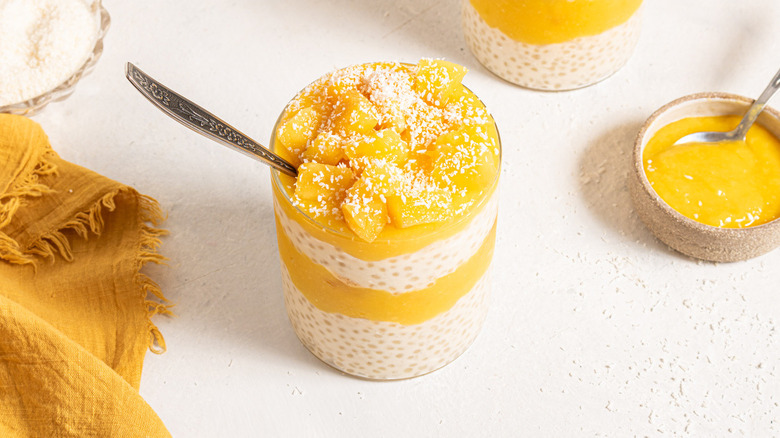
Ingredients
- 2 cups coconut milk
- ¼ cup honey
- 1 teaspoon vanilla paste
- ¼ cup shredded coconut
- 2 large mangos
- ½ cup tapioca pearls
Directions
- In a saucepan over medium heat, combine the coconut milk, honey, vanilla, and shredded coconut.
- While whisking, let the mixture come to a boil. Remove it from the heat and let it cool.
- Cut the mangos into cubes.
- Add half of the mango to a food processor or blender and blend until smooth. Save the other half for later.
- Bring a pot of water to a boil.
- Add the tapioca pearls to the boiling water and cook for about 10 minutes, or until the pearls are mostly translucent with tiny white specs left in the center.
- Drain the tapioca pearls through a sieve and rinse with cold water to stop them from cooking and sticking to each other.
- Add the tapioca to the cooled coconut milk mixture and stir together.
- Cover and let it sit in the fridge for at least 2 hours and up to overnight to thicken. If you prefer a looser consistency, you can eat it 30 minutes to 1 hour after you make it.
- When you're ready to enjoy the pudding, assemble the tapioca, mango puree, and cubed mango in alternating layers in a glass, jar, or bowl.
Nutrition
| Calories per Serving | 692 |
| Total Fat | 37.7 g |
| Saturated Fat | 32.8 g |
| Trans Fat | 0.0 g |
| Cholesterol | 0.0 mg |
| Total Carbohydrates | 93.8 g |
| Dietary Fiber | 5.9 g |
| Total Sugars | 63.1 g |
| Sodium | 26.5 mg |
| Protein | 6.0 g |
What is the history of mango sago?
Mango sago pudding was first created in 1984 at a Hong Kong restaurant called Lei Garden when the restaurant wanted to add a new summertime dessert to the menu. The name the pudding went by at first translated to "pomelo mango sago," with pomelos being the grapefruit-like citrus fruits used to garnish the dish (Manolova opts to use additional mango, instead). While the dessert they came up with was delicious, it didn't really catch on at first. Sweet, fruity desserts are pretty plentiful in Hong Kong in the summertime, so it needed more of a gimmick to catch people's attention.
Once the restaurateurs changed the name to a Cantonese phrase meaning "sweet dew of the willow branch", they had a hit on their hands. Not just because of the poetry of the name, but because it refers to a story about the Bodhisattva Guanyin. This Buddhist deity, known for her compassion, is said to have used dew from a willow branch to restore a magical ginseng tree that had been destroyed by the malicious Monkey King. Due to the name's association with the story, mango sago is seen as auspicious, and the change did indeed prove lucky for the dessert, since it's now sold by restaurants all over Hong Kong and also on the Chinese mainland.
What other flavors of sago can you make?
While mango is the classic flavor for this coconut milk sago pudding, Manolova notes that you could use other types of fruits if you'd like to do a little experimenting with different flavors. She suggests that a melon such as honeydew would work, as would strawberries or bananas. As a large mango will yield about 1 ½ cups of chopped fruit, you'll need an equal amount of another fruit to make the pudding.
As for the fruit used to garnish the dish, you could do as Manolova does and go with the same fruit you used to make the pudding, or you could choose a different one — for example, strawberry sago garnished with blueberries. If you can find any pomelos, you could try to recreate the original "sweet dew of the willow branch," or you could use grapefruit since this may be the closest substitute that's readily available. Manolova also tells us that, "As the texture of sago is soft and delicate, some crunchy toppings will create a nice contrast," suggesting that chopped nuts or dried fruits could add a different texture to the dish — pistachios go particularly well with mango.
